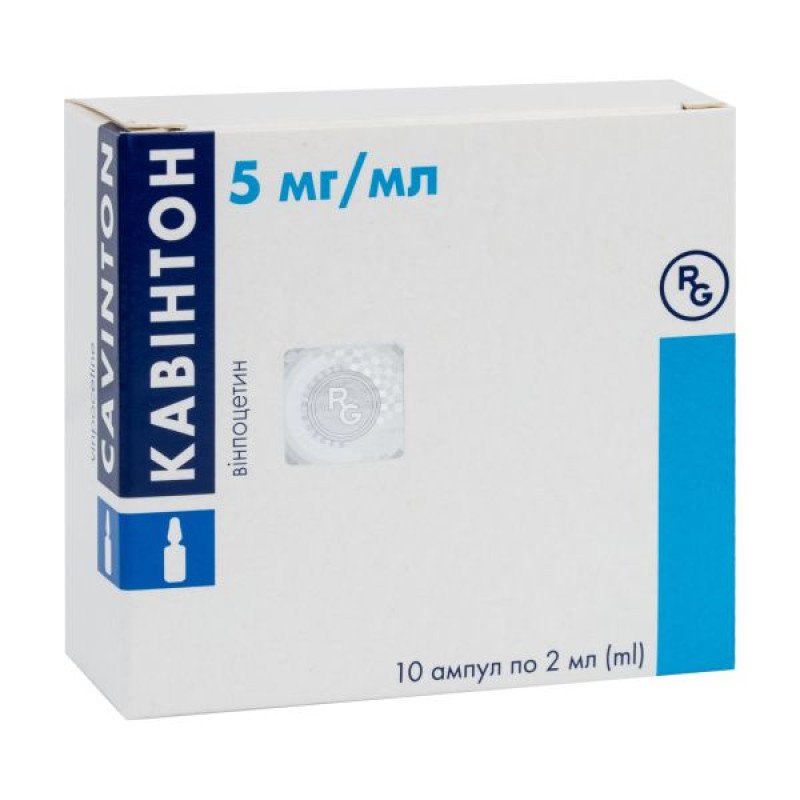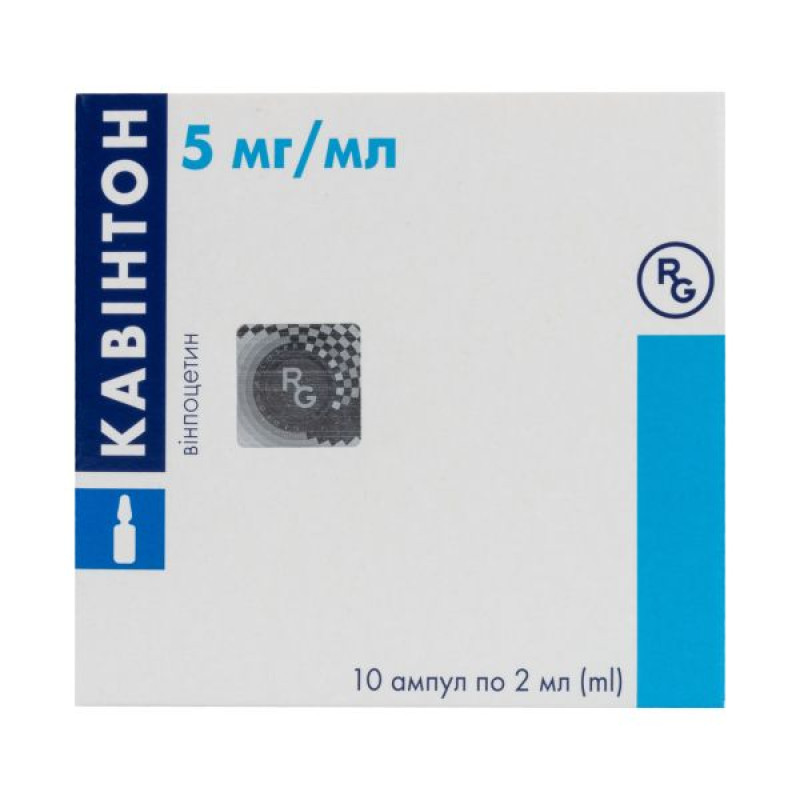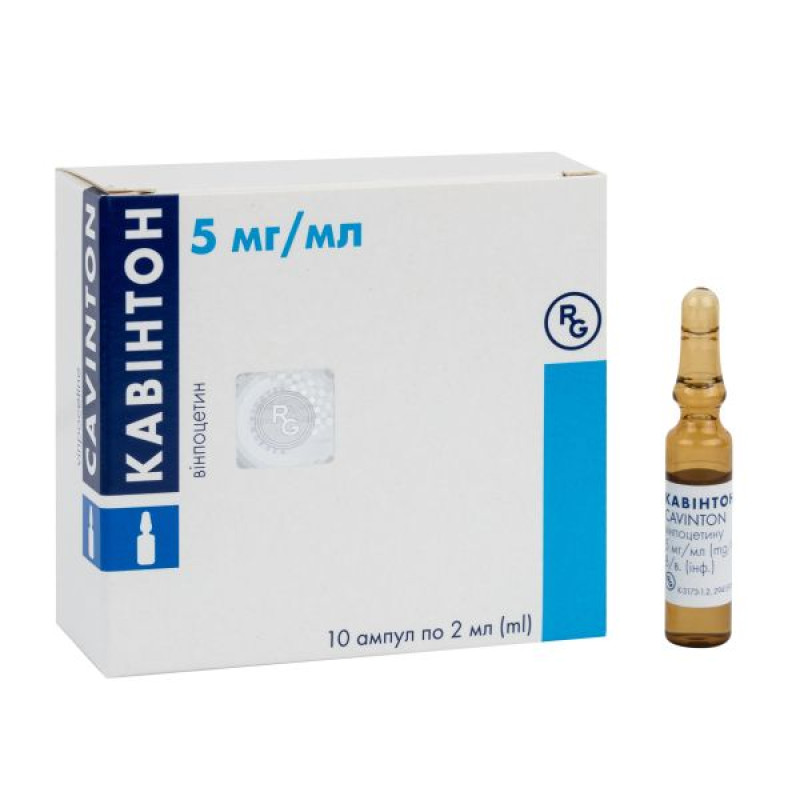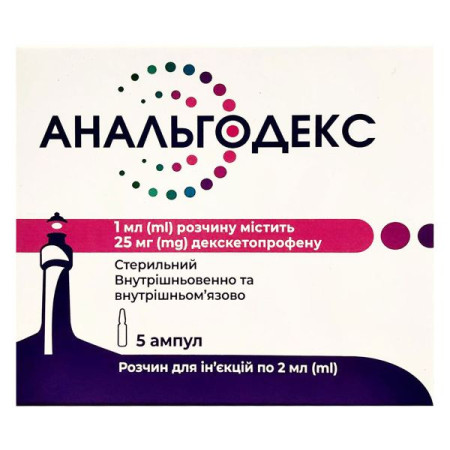Cavinton concentrate for solution for infusion 5 mg/ml ampoule 2 ml No. 10

Instructions Cavinton concentrate for solution for infusion 5 mg/ml ampoule 2 ml No. 10
Composition
active ingredient: vinpocetine;
1 ml of concentrate for solution for infusion contains 5 mg of vinpocetine;
Excipients: ascorbic acid, sodium metabisulfite (E 223), tartaric acid, benzyl alcohol, sorbitol (E 420), water for injections.
Dosage form
Concentrate for solution for infusion.
Main physicochemical properties: colorless or slightly greenish, transparent solution.
Pharmacotherapeutic group
Psychoanaleptics. Psychostimulants and nootropic substances. ATX code N06B X18.
Pharmacological properties
Pharmacodynamics
Vinpocetine is a compound with a complex mechanism of action that has a beneficial effect on brain metabolism and improves its blood supply, as well as improves the rheological properties of blood.
Vinpocetine exhibits neuroprotective effects: the drug attenuates the harmful effects of cytotoxic reactions caused by stimulating amino acids. The drug inhibits voltage-gated Na+ and Ca2+ channels, as well as NMDA and AMPA receptors. The drug enhances the neuroprotective effect of adenosine.
Vinpocetine stimulates cerebral metabolism: the drug increases the uptake of glucose and O2 and the consumption of these substances by brain tissue. The drug increases the brain's resistance to hypoxia; increases the transport of glucose - the exclusive source of energy for the brain - across the blood-brain barrier; shifts glucose metabolism towards the energetically more favorable aerobic pathway; selectively inhibits the Ca2+-calmodulin-dependent enzyme cGMP-phosphodiesterase (PDE); increases the level of cAMP and cGMP in the brain. The drug increases the concentration of ATP and the ATP/AMP ratio; enhances the turnover of noradrenaline and serotonin in the brain; stimulates the ascending noradrenergic system; has antioxidant activity; as a result of all the above effects, vinpocetine has a cerebroprotective effect.
Vinpocetine improves microcirculation in the brain: the drug inhibits platelet aggregation, reduces pathologically increased blood viscosity, increases erythrocyte deformability and inhibits adenosine uptake, improves O2 transport in tissues by reducing the affinity of O2 for erythrocytes.
Vinpocetine selectively increases blood flow in the brain: the drug increases the cerebral fraction of cardiac output; reduces vascular resistance in the brain without affecting the parameters of systemic circulation (blood pressure, cardiac output, pulse rate, total peripheral resistance); the drug does not cause a “stealing effect”. Moreover, against the background of the drug, blood flow to damaged (but not yet necrotic) areas of ischemia with low perfusion (“reverse steal effect”) improves.
Pharmacokinetics
Distribution. In oral studies in rats, radiolabeled vinpocetine was found in the liver and gastrointestinal tract in the highest concentrations. Maximum tissue concentrations were detected 2-4 hours after administration. The concentration of radioactivity in the brain did not exceed the concentration in the blood.
In humans: binding to blood proteins is 66%. Absolute oral bioavailability of vinpocetine is 7%. The volume of distribution is 246.7 ± 88.5 l, which indicates a pronounced binding of the substance in the tissues. The clearance value of vinpocetine (66.7 l/h) exceeds the values in plasma and in the liver (50 l/h), which indicates extrahepatic metabolism of the compound.
Excretion. After repeated oral administration of 5 mg and 10 mg vinpocetine exhibits linear kinetics; steady-state plasma concentrations are 1.2 ± 0.27 ng/ml and 2.1 ± 0.33 ng/ml, respectively. The elimination half-life in humans is 83 ± 1.29 hours. In studies conducted with a radiolabeled compound, the major route of excretion was via urine and feces in a ratio of 60%:40%. A greater amount of the radiolabel in rats and dogs was found in the bile, but no significant enterohepatic circulation was observed. Apovincamic acid is excreted by the kidneys by simple glomerular filtration; the elimination half-life of this substance varies depending on the dose and route of administration of vinpocetine.
Metabolism. The main metabolite of vinpocetine is apovincamic acid (AVC), which is formed in humans in 25-30%. After oral administration, the area under the curve ("concentration - time") of AVC is twice as high as after intravenous administration of the drug, indicating the formation of AVC in the process of presystemic metabolism of vinpocetine. Other metabolites identified are hydroxyvinpocetine, hydroxy-AVC, dihydroxy-AVC-glycinate and their conjugates with glucuronides and/or sulfates. In each of the studied species, the amount of vinpocetine excreted unchanged was only a few percent of the dose of the drug.
Changes in pharmacokinetic properties in special circumstances (for example, at a certain age, in the presence of concomitant diseases). Since vinpocetine is indicated for the treatment of mainly elderly patients, in whom changes in the kinetics of drugs are observed - reduced absorption, different distribution and metabolism, reduced excretion - it was necessary to conduct a study to assess the kinetics of the drug in this age group, especially with long-term use. The results of such studies have shown that the kinetics of vinpocetine in elderly people do not differ significantly from the kinetics of vinpocetine in young people, and, in addition, there is no accumulation. In case of impaired liver or kidney function, normal doses of the drug can be used, since vinpocetine does not accumulate in the body of such patients, which allows taking the drug for a long time.
Indication
Neurology. For the treatment of various forms of cerebrovascular pathology: conditions after a stroke, vertebrobasilar insufficiency, vascular dementia, cerebral atherosclerosis, post-traumatic and hypertensive encephalopathy. Helps reduce mental and neurological symptoms in cerebrovascular pathology.
Ophthalmology. For the treatment of chronic vascular pathology of the choroid (the vascular membrane of the eye) and retina.
Otorhinolaryngology. For the treatment of senile hearing loss in acute vascular pathology, toxic (drug) damage or damage of a different nature (idiopathic, due to noise exposure), Meniere's disease and tinnitus.
Contraindication
Acute phase of hemorrhagic cerebral stroke, severe ischemic heart disease, severe forms of arrhythmia.
Pregnancy, breastfeeding. Contraindicated for women of reproductive age who are not using a reliable method of contraception.
Hypersensitivity to the active substance or to any of the excipients.
The use of the drug in children is contraindicated (due to the lack of data from relevant clinical studies).
Interaction with other medicinal products and other types of interactions
During clinical studies, no interaction between vinpocetine and beta-blockers such as cloranolol and pindolol, as well as with clopamide, glibenclamide, digoxin, acenocoumarol or hydrochlorothiazide was found. In isolated cases, some additive effect was observed with the simultaneous use of alpha-methyldopa and vinpocetine, therefore, regular blood pressure monitoring is necessary when using this combination of drugs.
Although clinical trial data have not confirmed interactions, caution is recommended when vinpocetine is used concomitantly with drugs that affect the central nervous system, as well as in the case of concomitant antiarrhythmic and anticoagulant therapy.
Application features
If the patient has increased intracranial pressure, arrhythmia or long QT syndrome, as well as against the background of the use of antiarrhythmic drugs, a course of therapy with the drug can be started only after a thorough analysis of the benefits and risks associated with the use of the drug.
QT prolongation
ECG monitoring is recommended in the presence of long QT syndrome or concomitant use of a drug that prolongs the QT interval.
Excipients
The drug contains a small amount of sorbitol (160 mg/2 mg), so if a patient has diabetes, it is necessary to periodically monitor blood sugar levels during the course of drug therapy.
In case of fructose intolerance or fructose-1,6-diphosphatase enzyme deficiency, the use of the medicinal product should be avoided. Before using this medicinal product, a detailed medical history should be taken from each patient regarding hereditary symptoms of fructose intolerance.
Due to the content of benzyl alcohol (20 mg in 2 ml), hypersensitivity reactions may occur. Large volumes of this excipient should be used with caution and only when necessary, especially in patients with impaired liver or kidney function, due to the risk of accumulation and toxicity (metabolic acidosis).
Due to the content of sodium metabisulfite (2 mg in 2 ml), the drug may in rare cases cause serious allergic reactions and bronchospasm.
This medicine contains less than 1 mmol (23 mg) sodium per ampoule, i.e. essentially 'sodium-free'.
Mutagenicity. Vinpocetine does not have a mutagenic effect.
Carcinogenicity. Vinpocetine does not have a carcinogenic effect.
Use during pregnancy or breastfeeding
Vinpocetine is contraindicated during pregnancy, breastfeeding, and for women of reproductive age who do not use a reliable method of contraception.
Pregnancy. Vinpocetine crosses the placenta, but is found in lower concentrations in the placenta and fetal blood than in maternal blood. Animal studies have shown reproductive toxicity, including malformations. In animal studies, administration of high doses of vinpocetine was accompanied in some cases by placental bleeding and miscarriage, probably as a result of increased placental blood flow.
Breastfeeding. Vinpocetine passes into breast milk. In studies using labeled vinpocetine, the radioactivity in breast milk was ten times higher than in maternal blood. The amount excreted in milk within 1 hour is 0.25% of the administered dose. Since vinpocetine passes into breast milk and there is no data on the effect on the newborn, the use of vinpocetine during breastfeeding is contraindicated.
Ability to influence reaction speed when driving vehicles or other mechanisms
There is no data on the effect of vinpocetine on the ability to drive and use machines, but the possibility of drowsiness, dizziness, and vertigo should be taken into account when using the drug.
Method of administration and doses
The drug is allowed to be used only as a slow intravenous drip infusion! (The infusion rate should not exceed a maximum of 80 drops/minute!)
The drug cannot be administered intramuscularly, and the drug cannot be administered intravenously without dilution!
The initial daily dose for adults is usually 20 mg in 500 ml of solution for infusion. This dose may be increased to 1 mg/kg body weight per day for 2-3 days, depending on the patient's tolerance.
The average duration of the course of therapy is 10-14 days, the usual daily dose is 50 mg/day (50 mg in 500 ml of infusion solution) - based on a body weight of 70 kg.
After completing the course of infusion therapy, it is recommended to continue the patient's therapy with Cavinton in tablet form.
Cavinton, concentrate for solution for infusion, can be diluted with any type of physiological solution or infusion solutions containing glucose (e.g. Salsol, Ringer's solution, Rindex, Rheomacrodex). The infusion solution should be used within 3 hours of preparation. See also the section "Incompatibility".
Renal and hepatic impairment
Patients with kidney or liver disease do not require dosage adjustment.
Children
The use of the drug in children is contraindicated (due to the lack of data from relevant clinical studies).
Overdose
Based on literature data, administration of the drug at a dose of 1 mg/kg body weight can be considered safe. Since there are no data on the use of the drug at doses exceeding this dose, administration of the drug at higher doses is not allowed.
Adverse reactions
Cavinton concentrate for solution for infusion is a safe drug, which was confirmed by safety evaluation studies that included data on tens of thousands of patients and demonstrated that even those undesirable effects that occurred most frequently did not fall into the category "Frequent >1/100" according to the MedDRA definition, i.e. side effects with the highest probability of occurrence were recorded with a frequency of less than 1%. For this reason, the frequency category "Frequent" is absent in the table below.
Adverse reactions are listed below by system organ class and frequency according to MedDRA terminology:
Table 1.
| Organ system class | Infrequently (≥1/1000 - <1/100) | Rarely (≥1/10000 - <1/1000) | Very rare (<1/10000) |
| Blood and lymphatic system disorders | Thrombocytopenia Agglutination of red blood cells | Anemia | |
| On the part of the immune system | Hypersensitivity | ||
| Metabolism and nutrition | Hypercholesterolemia Diabetes mellitus | Anorexia | |
| Mental disorders | Euphoria | Concern Excitation | Depression |
| From the nervous system | Headache Dizziness Hemiparesis Drowsiness | Tremor Loss of consciousness Hypotension State before loss of consciousness | |
| From the organs of vision | Hyphema Hyperopia Decreased visual acuity Myopia | Conjunctival hyperemia Optic nerve papilla swelling Diplopia | |
| From the side of the organs of hearing and labyrinth | Hearing impairment Hyperacusis Hearing loss Vertigo | Tinnitus | |
| From the heart | Myocardial ischemia/infarction Angina pectoris Arrhythmia Bradycardia Tachycardia Extrasystole Feeling of heart palpitations | Heart failure Atrial fibrillation | |
| From the vascular side | Arterial hypotension Arterial hypertension Tides | Blood pressure fluctuations Venous insufficiency | |
| Gastrointestinal tract | Epigastric discomfort Dry mouth Nausea | Hypersecretion of saliva Vomiting | Skin and subcutaneous tissue disorders | Erythema Hyperhidrosis Urticaria | Dermatitis Itch |
| General disorders and administration site conditions | Feeling hot | Asthenia Chest discomfort Inflammation/thrombosis at the injection site | |
| Research results | Lowering blood pressure | Increased blood pressure QT prolongation on ECG ST segment depression on ECG Increased blood urea levels | Level Up lactate dehydrogenase Prolongation of the PR interval on the ECG ECG changes |
Expiration date
5 years.
Storage conditions
Store at a temperature not exceeding 25 0C in the original packaging to protect from light. Keep the drug out of the reach of children.
Incompatibility
The concentrate for solution for infusion is chemically incompatible with heparin, so they cannot be mixed in the same syringe. However, concomitant anticoagulant treatment can be carried out.
The concentrate for the preparation of an infusion solution is also incompatible with infusion solutions containing amino acids, therefore, during treatment, vinpocetine infusion should not be used together with infusion solutions containing amino acids.
Packaging
2 ml in an ampoule; 5 ampoules in a plastic mold; 2 plastic molds in a cardboard box.
Vacation category
By prescription. For use in a hospital setting only.
Producer
JSC "Gedeon Richter".
Location of the manufacturer and its business address
H-1103, Budapest, Demrei Street 19-21, Hungary
There are no reviews for this product.
There are no reviews for this product, be the first to leave your review.
No questions about this product, be the first and ask your question.


















